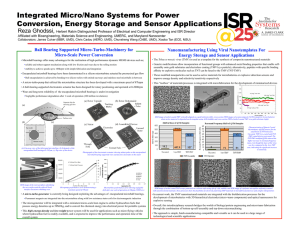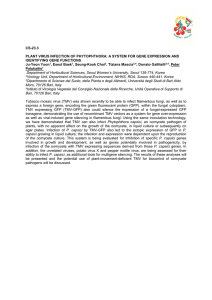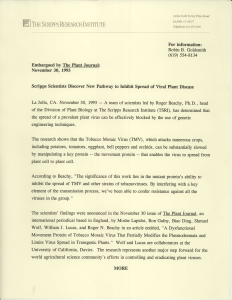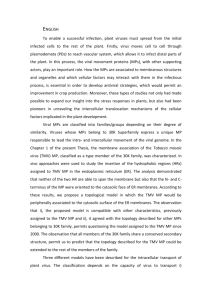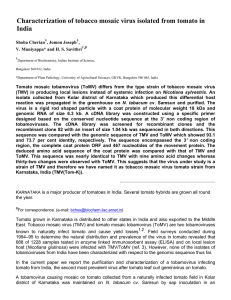VIRAL ENGINEERED MEMS
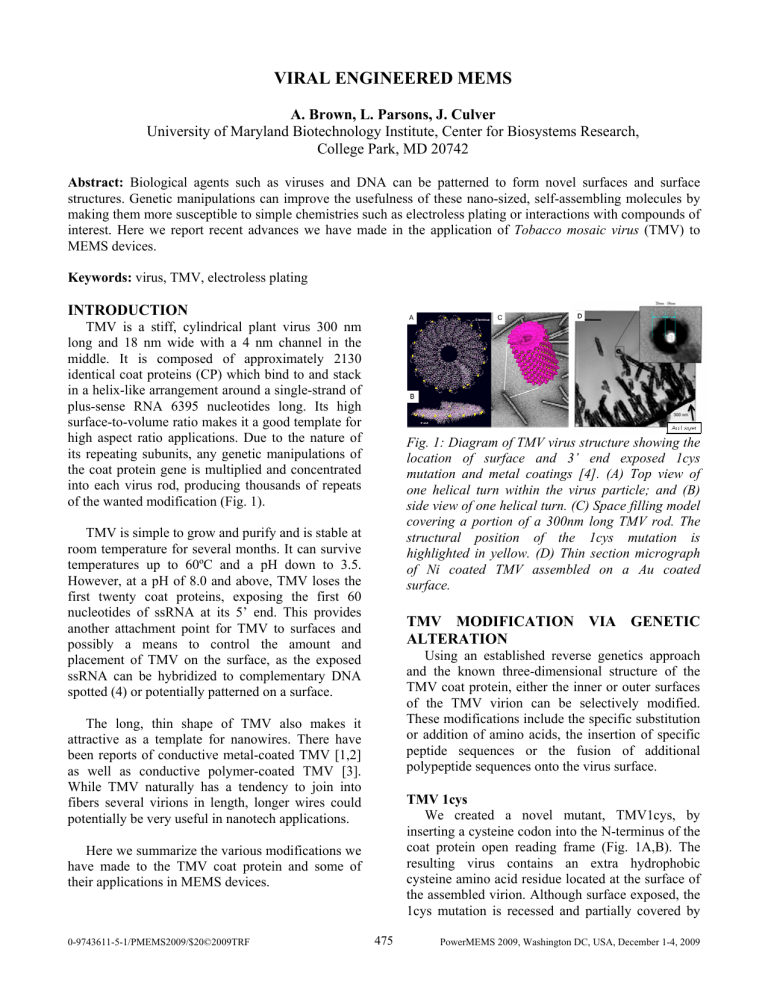
VIRAL ENGINEERED MEMS
A. Brown, L. Parsons, J. Culver
University of Maryland Biotechnology Institute, Center for Biosystems Research,
College Park, MD 20742
Abstract: Biological agents such as viruses and DNA can be patterned to form novel surfaces and surface structures. Genetic manipulations can improve the usefulness of these nano-sized, self-assembling molecules by making them more susceptible to simple chemistries such as electroless plating or interactions with compounds of interest. Here we report recent advances we have made in the application of Tobacco mosaic virus (TMV) to
MEMS devices.
Keywords: virus, TMV, electroless plating
INTRODUCTION
TMV is a stiff, cylindrical plant virus 300 nm long and 18 nm wide with a 4 nm channel in the middle. It is composed of approximately 2130 identical coat proteins (CP) which bind to and stack in a helix-like arrangement around a single-strand of plus-sense RNA 6395 nucleotides long. Its high surface-to-volume ratio makes it a good template for high aspect ratio applications. Due to the nature of its repeating subunits, any genetic manipulations of the coat protein gene is multiplied and concentrated into each virus rod, producing thousands of repeats of the wanted modification (Fig. 1).
TMV is simple to grow and purify and is stable at room temperature for several months. It can survive temperatures up to 60ºC and a pH down to 3.5.
However, at a pH of 8.0 and above, TMV loses the first twenty coat proteins, exposing the first 60 nucleotides of ssRNA at its 5’ end. This provides another attachment point for TMV to surfaces and possibly a means to control the amount and placement of TMV on the surface, as the exposed ssRNA can be hybridized to complementary DNA spotted (4) or potentially patterned on a surface.
The long, thin shape of TMV also makes it attractive as a template for nanowires. There have been reports of conductive metal-coated TMV [1,2] as well as conductive polymer-coated TMV [3].
While TMV naturally has a tendency to join into fibers several virions in length, longer wires could potentially be very useful in nanotech applications.
Here we summarize the various modifications we have made to the TMV coat protein and some of their applications in MEMS devices.
Fig. 1: Diagram of TMV virus structure showing the location of surface and 3’ end exposed 1cys mutation and metal coatings [4]. (A) Top view of one helical turn within the virus particle; and (B) side view of one helical turn. (C) Space filling model covering a portion of a 300nm long TMV rod. The structural position of the 1cys mutation is highlighted in yellow. (D) Thin section micrograph of Ni coated TMV assembled on a Au coated surface.
TMV MODIFICATION VIA GENETIC
ALTERATION
Using an established reverse genetics approach and the known three-dimensional structure of the
TMV coat protein, either the inner or outer surfaces of the TMV virion can be selectively modified.
These modifications include the specific substitution or addition of amino acids, the insertion of specific peptide sequences or the fusion of additional polypeptide sequences onto the virus surface.
TMV 1cys
We created a novel mutant, TMV1cys, by inserting a cysteine codon into the N-terminus of the
coat protein open reading frame (Fig. 1A,B). The
resulting virus contains an extra hydrophobic cysteine amino acid residue located at the surface of the assembled virion. Although surface exposed, the
1cys mutation is recessed and partially covered by
0-9743611-5-1/PMEMS2009/$20©2009TRF 475 PowerMEMS 2009, Washington DC, USA, December 1-4, 2009
the C-terminal arm of the coat protein. This position likely inhibits direct contact between the cysteinederived thiol and the gold surface except at the 3' end of the virion rod where the thiol group is sufficiently exposed to make direct contact with the gold surface. This positioning of the 1cys mutation directs the robust attachment of viral rods onto gold
with a largely vertical orientation (Fig. 1D)
significantly increasing available surface area.
The 1cys mutation provides an additional function as a mediator in deposition of metal onto the surface of the virus.
Our group developed electroless plating methods utilizing TMV 1cys with which we obtained even, near uniform inorganic coatings of Ni (Fig. 2,3), Co, Pt, and silica on patterned virus template as well as partial coatings of
Pd, Ag, and Au. The thin surface coating of the virus combined with the attachment and perpendicular orientation to the underlying gold surface has allowed the creation of very high surface area metal surfaces which have shown success as improved electrodes for use in batteries. These metal-coated
TMV 1cys surfaces are highly stable and have been shown to maintain their conformation under repeated charge-discharge cycles within an alkaline electrode system [4].
TMV 3His
Another novel mutant, TMV 3his, was created by inserting three adjacent histidine codons into the Nterminus of the coat protein open reading frame. The addition of these histidine residues to the virus surface appears to confer reversible binding for the scavenging of metal ions.
TMV 3his virus was suspended in water and in an aqueous solution of 50mM NiCl
2
and then centrifuged. The supernatant was removed, and the pellet resuspended in a solution of 200mM imidizole. An SDS-PAGE gel showed that while the virus had remained suspended in water, the virus in the presence of Ni
2+
had precipitated and was pelleted during centrifugation. The reversibility of this process points to its potential use in bioremediation and detection of contaminating metals.
Fig. 2: TEM image of a nickel-coated 1cys TMV
Fig. 3: SEM image of nickel-coated 1cys TMV bound to a gold surface.
476
Fig. 4: SDS-PAGE of TMV 3his. Lanes 1 and 2:
Supernatant and pellet of aqueous suspension of
TMV 3his. Lanes 3 and 4: Supernatant and pellet of suspension of TMV 3his in 50mM NiCl
2
(resuspended with 200mM imidizole).
Peptide modification
Our lab has also experimented with adding peptides and entire protein domains to the TMV surface. These could be used in sensor, filtration, or possibly solar energy applications. Because of the size of some of the peptides and their effect on the assembly and infectivity of the virus, attachment of the peptide to each coat protein subunit may not be feasible.
To overcome this problem we altered the viral genome, adding a ‘leaky’ amber stop codon between the coat protein gene and the attached peptide. During the translation of the coat protein from the viral genome, this amber stop codon is not always interpreted as the end of the gene, so translation sometimes continues beyond to the attached peptide. This allows expression of a combination of modified and wild type coat proteins. This mixture of coat protein is capable of
proper virion assembly and plant infection, although with reduced virulence compared to wild type, and still incorporates expression the desired peptide (Fig.
5).
Fig. 5: Western immunoblot SDS-PAGE of coat protein from N. benthamiana infected with (1) wild type TMV, (2) TMV with a 12-amino acid peptide attached by a ‘leaky’ amber stop codon, and (3)
TMV with C-terminally attached LUV protein. The double band visible in (2) shows expression of coat protein subunits both with and without the additional peptide sequence.
OTHER TMV APPLICATIONS
Patterned TMV
We’ve already shown that RNA exposed at the 5’ end of TMV can hybridize with DNA. We are attempting to use this feature to pattern TMV by binding it to grids formed from DNA. The ability to control the separation of TMV will be useful when applying thick coatings to surface-bound TMV.
There are many reports of patterned DNA including grids [6], triangles [7], and even happy faces [8].
We’ve chosen a simple grid pattern constructed of two ‘tiles’ with anti-parallel double helices forming the ‘arms’ of each tile. The tiles fit together with complementary 5’ overhangs (Fig. 6). So far we have constructed the tiles and shown that they bind TMV. We are attempting to directly visualize the formation of the grid and the patterning of TMV upon the grid.
Fig. 6: ddDNA design. (A) Single tile. Each colored line represents unique single-stranded primers in the core tile. The gray lines are complementary to the colored lines and the unmatched ends of the gray lines are complementary to the unmatched ends in other tiles. The extra green piece next to the center
477 of the tile is complementary to TMV’s RNA. (B)
Four tiles form a grid. (C) A larger grid with TMV
(vertical columns) attached.
CONCLUSIONS
The Tobacco Mosaic Virus appears to be a promising element in the creation of MEMS devices by providing a modifiable substrate with high surface area. Incorporation of TMV into MEMS systems is possible by surface attachment with vertical positioning through the 1cys mutation or potentially by attachment to DNA grids for more precise patterning. We have also shown that the potential functionality of the surface provided by
TMV is highly modifiable. Through relatively minor genetic changes, we have modified the surface properties for a variety of functional uses within the system. Other desired modifications of the virus by attachment of larger peptides have also been shown to be possible.
ACKNOWLEDGMENTS
This work was supported in part by the
Department of Energy-Basic Energy Sciences DE-
FG02-02ER45975
REFERENCES
[1] Gorzny M.L. et.al. 2008 Four-probe electrical characterization of Pt-coated TMV-based nanostructures Nanotechnology 19 (16) 165704
[2] Balci S. et.al. 2006 Copper nanowires within the central channel of tobacco mosaic virus particles
Electrochimica Acta . 51 (28) 6251-6257
[3] Niu Z. et.al. 2007 Biological templated synthesis of water-soluble conductive polymeric nanowires
Nano Letters . 7 (12) 3729-3733
[4] Royston E., et.al. 2008
Self-assembly of virus structured high surface area nano-materials and their application as battery electrodes.
Langmuir
24 (3) 906-912
[5] Yi H. et.al. 2007 TMV Microarrays:
Hybridization-Based Assembly of DNA-
Programmed Viral Nanotemplates Langmuir 23 (5)
2663-2667
[6] Yan H. et.al. 2003 DNA-Templated Self-
Assembly of Protein Arrays and Highly Conductive
Nanowires Science 301 1882
[7] Chelyapov N. et.al. 2004 DNA Triangles and
Self-Assembled Hexagonal Tilings J. Am. Chem.
Soc. 126 (43) 13924-13925
[8] Rothemond P.W.K. 2006 Folding DNA to create nanoscale shapes and patterns Nature 440 (16) 297-
302
